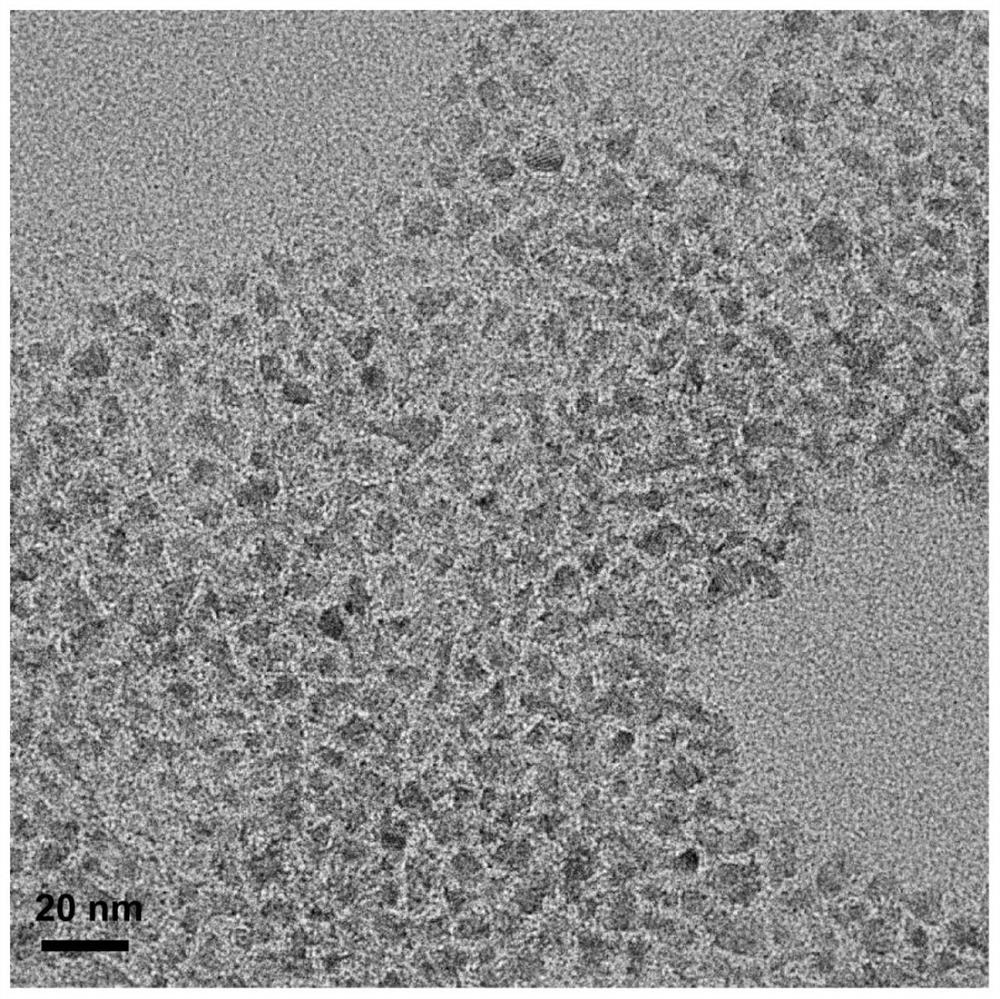Fluorescent quantum dot nanoprobe, preparation method thereof and application of fluorescent quantum dot nanoprobe in detection of circulating tumor cells
A technology of fluorescent quantum dots and tumor cells, applied in the field of biological detection, can solve the problem that heavy metal elements are not suitable for biological detection, etc., and achieve the effects of good identification ability and stability, strong anti-interference ability, high sensitivity and anti-interference ability
- Summary
- Abstract
- Description
- Claims
- Application Information
AI Technical Summary
Problems solved by technology
Method used
Image
Examples
preparation example 1
[0082] Based on CuInSe 2 The preparation method of the circulating tumor cell fluorescent detection probe of quantum dots is as follows:
[0083] 1) Weigh 10mg of oil-soluble CuInSe 2 Quantum dots, and dissolved in 10mL chloroform, then added 40mg of DSPE-PEG-COOH, stirred for 10min, the mixed liquid was evaporated to dryness with a rotary evaporator, then added 10mL ultrapure water, ultrasonically dissolved for 15min, to obtain water-soluble CuInSe 2 Quantum dots, stored at room temperature for later use.
[0084] 2) Weigh 20 mg of the water-soluble CuInSe prepared in step 1) 2 Quantum dots, 15mg NHS and 10mg EDC, added 5mL MES buffer (50mmol / L, pH 5.6), stirred at room temperature for 20min, centrifuged at 21000rpm for 10min, removed the supernatant, added 5mL PBS buffer (50mmol / L , pH=7.4), and then added 10 μL of anti-EpCAM antibody, placed on a rotary mixer, and reacted at 4° C. for 2 hours. Centrifuge at 21,000 rpm for 10 min, remove the upper layer, and disperse in ...
Embodiment 1
[0088] The feasibility of measuring the number of circulating tumor cells by the detection probe obtained in Preparation Example 1 is investigated, including the following steps:
[0089] 1) Coating: Dilute the capture probe anti-EpCAM antibody to 10 μg / mL with 0.05 mol / L carbonate buffer, add 100 μL of the dilution to each well of a 96-well plate, and incubate at 37°C for 1 hour , the liquid in the well was discarded, and then washed 3 times with PBS washing buffer.
[0090] 2) Blocking: add 300 μL of BSA solution (2% w / v) prepared with PBS buffer to each well, incubate at 37° C. for 1 hour, discard the liquid in the well, and wash 3 times with PBS washing buffer.
[0091] 3) Adding samples: culture breast cancer (MCF-7) cells with DMEM cell culture medium (containing 10wt% fetal bovine serum, 100 μg / mL penicillin and 100 μg / mL streptomycin), and after they grow to a certain number, use pancreatic Protease digestion was performed and the cells were harvested and made into a ...
Embodiment 2
[0096] Examination of selectivity of detection probes for circulating tumor cell types.
[0097] 1. the reagent used in this experiment and instrument are identical with embodiment 1, used CuInSe 2 The quantum dot circulating tumor cell fluorescence detection probe is consistent with that of Example 1.
[0098] 2. Examine CuInSe 2 The selectivity of quantum dot detection probes to circulating tumor cell types comprises the following steps:
[0099] 1) Coating: Dilute the capture probe anti-EpCAM antibody to 10 μg / mL with 0.05 mol / L carbonate buffer, add 100 μL of the dilution to each well of a 96-well plate, and incubate at 37°C for 1 hour , the liquid in the well was discarded, and then washed 3 times with PBS washing buffer.
[0100] 2) Blocking: add 300 μL of BSA solution (2% w / v) prepared with PBS buffer to each well, incubate at 37° C. for 1 hour, discard the liquid in the well, and wash 3 times with PBS washing buffer.
[0101] 3) Sample addition: Breast cancer (MCF-...
PUM
| Property | Measurement | Unit |
|---|---|---|
| particle size | aaaaa | aaaaa |
| particle size | aaaaa | aaaaa |
Abstract
Description
Claims
Application Information
 Login to View More
Login to View More - R&D
- Intellectual Property
- Life Sciences
- Materials
- Tech Scout
- Unparalleled Data Quality
- Higher Quality Content
- 60% Fewer Hallucinations
Browse by: Latest US Patents, China's latest patents, Technical Efficacy Thesaurus, Application Domain, Technology Topic, Popular Technical Reports.
© 2025 PatSnap. All rights reserved.Legal|Privacy policy|Modern Slavery Act Transparency Statement|Sitemap|About US| Contact US: help@patsnap.com



